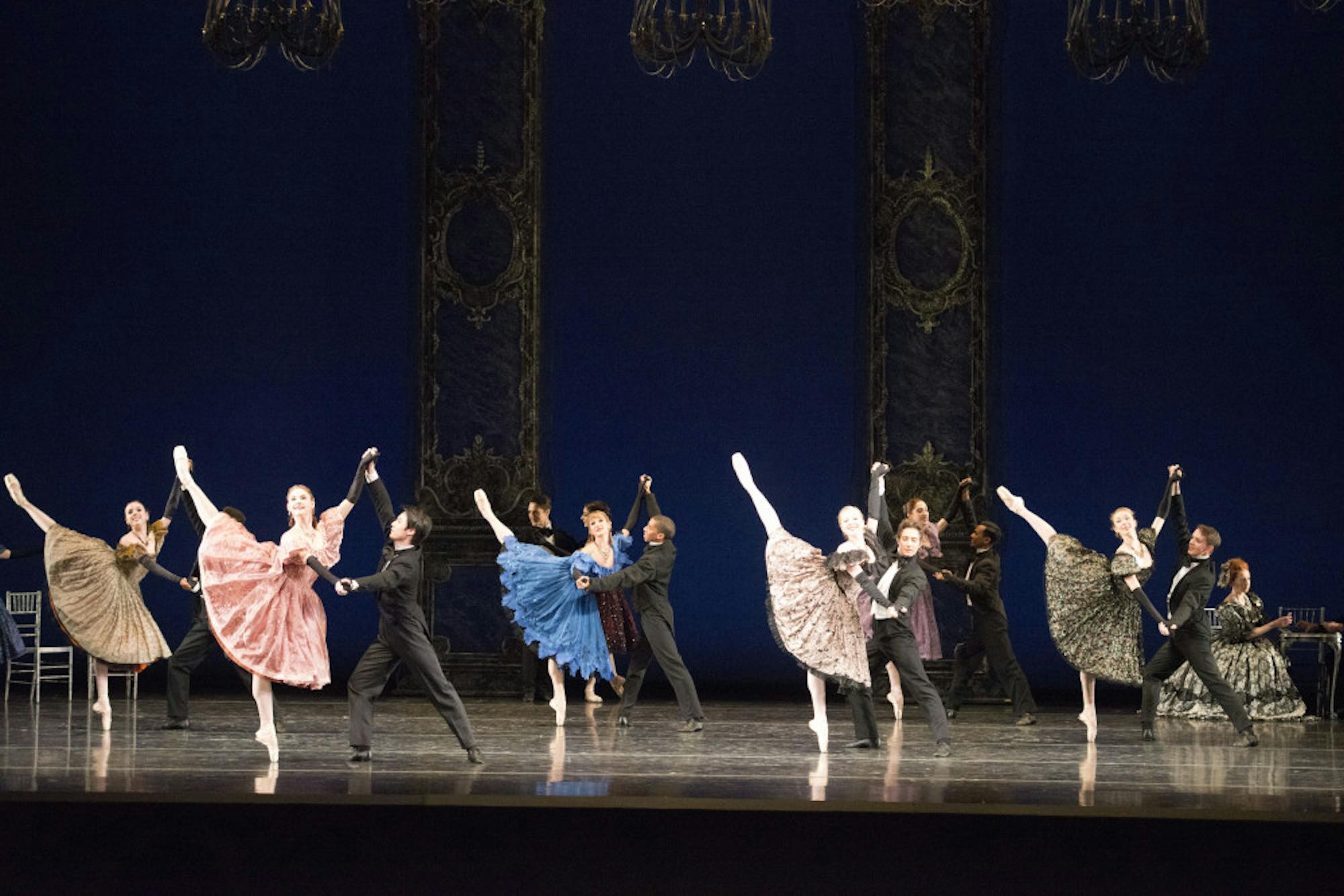The Spring 2015 season of the Boston Ballet opened with a beautiful rendition of “Lady of the Camellias” (John Neumeier's ballet version premiered in 1979), a devastatingly sad, yet beautifully told, story of forbidden love. The story starts in the apartment of Marguerite, a courtesan played by principal dancer Erica Cornejo, as she enjoys a night of champagne and flirting with the Parisian elite. Though societal obligations tie her to the Baron de Varville (soloist Bradley Schlagheck), amidst the revelry she finds herself attracted to Armand Duval, played by fellow principal dancer Lasha Khozashvili. She manages to share her feelings with Armand, secretly giving him a key to her boudoir before he leaves the party.
The scene changes to a stormy Parisian street, complete with the sound of thunder and rain as the audience sees Armand turn back toward Marguerite’s apartment, arriving just after she sends away the Baron. A beautiful pas de deux between Marguerite and Armand follows in which the relationship between the two is solidified. Despite her life of frivolity, there is an overhanging sense of foreboding; Marguerite is ill, and her health is set to deteriorate over the course of the production.
Act II opens with another social gathering, this time in late afternoon on a summer’s day. The breathtaking scenery, designed specifically for this act by Robert Glay de La Rose, includes an overhanging tree, two swings suspended from the roof of the stage and billowing white curtains set in window frames. A larger company graces this garden party than in the previous act, cheerfully chatting, dancing and playing games as Marguerite and Armand sit cozily together on a bench, observing the scene. The sense of intimacy is not only felt in the clear chemistry between Cornejo and Khozashvili as the romantic couple, but also in the choreography and placement of the other dancers. For example, at one point a ballerina sits center stage, right at the edge closest to the audience, allowing both the audience and the dancer to engage in the same action of watching the party together.
As the evening progresses, the peach sky behind the dancers deepens in color, foreshadowing the shift from the day's bliss that the night will bring. This feeling intensifies once Marguerite is left alone on stage after Armand goes off to play badminton with a friend. The young woman is approached by a man in a long dark coat, who appears to be yet another lover interested in the gorgeous, yet sickly, Marguerite. However, he turns out to be Armand’s father, Duval Sr. (second soloist Bo Busby) who has arrived to confront Marguerite, asking her to denounce her love for his son because they are socially unsuitable for each other. Marguerite is devastated, but she complies, shunning Armand and leading him to believe that she is in love with the Baron after all. The act ends with a moving pas de deux between Armand and his father, highlighting Armand’s grief. The figure of the tall, strong, darkly clad Duval Sr. contrasts with the limp figure of his son, whom he holds in his arms as the curtain falls.
This contrast continues in the opening of the third act, with curtains rising to reveal an ornate room at a party hosted by Olympe (soloist Dalay Parrondo), Marguerite’s rival. Gone is the happiness of the summer, the bright color scheme replaced by ballerinas adorned in heavier, darker dresses and black gloves. When a clearly sickened Marguerite arrives on the arm of the Baron de Varville, she finds that Olympe’s date is none other than Armand. Her grief at seeing the couple only worsens when Armand humiliates Marguerite in front of the guests, leading the Baron to challenge him to a duel.
The start of the final scene finds a wilting Marguerite facing the audience, a spotlight shining on her as her two lovers square off in the background. The sound of a gunshot jolts her to her feet, and she appears to almost flap across the stage like a bird -- an image which is reinforced by the sounds of birds of prey calling in the background.
The ballet makes use of repeated motifs that develop throughout the course of its three acts, mirroring Marguerite's transition from life to death. Props, costumes and music develop to indicate this deterioration of the main character. A series of repeated yet darker images and sounds transport the viewer from a material world of frivolity to an ethereal, deathly dream eliciting the feeling that the woman is very much alone. Examples of this occur in the form of a gliding female member of the demi-monde, her dress and parasol exchanged for those of a darker color; Marguerite’s elegant nightgown is exchanged for a simple slip.
The ambiguity of the final scene leaves the viewer pondering many questions. This uncertainty is amplified by the layout of the scene as a quasi-dream sequence where Marguerite's ailing health blurs the line between reality and dream for the audience. Which of Marguerite’s lovers dies? How does a woman of such wealth and stature finds herself alone at her death, with a sole camellia beyond the reach of her fingertips as the only reminder of a joyful summer? The combination of subtle elements of performance and the emotional choreography prove that there is no questioning the Boston Ballet's ability to execute a beautiful, moving performance.
'Lady of the Camellias' stuns with beautiful sets, emotive performances

The corps de ballet does beautiful ensemble work in Boston Ballet's "Lady of the Camellias."
Summary
Boston Ballet's "Lady of the Camellias" stuns with beautiful sets and emotive performances.
4.5 Stars





